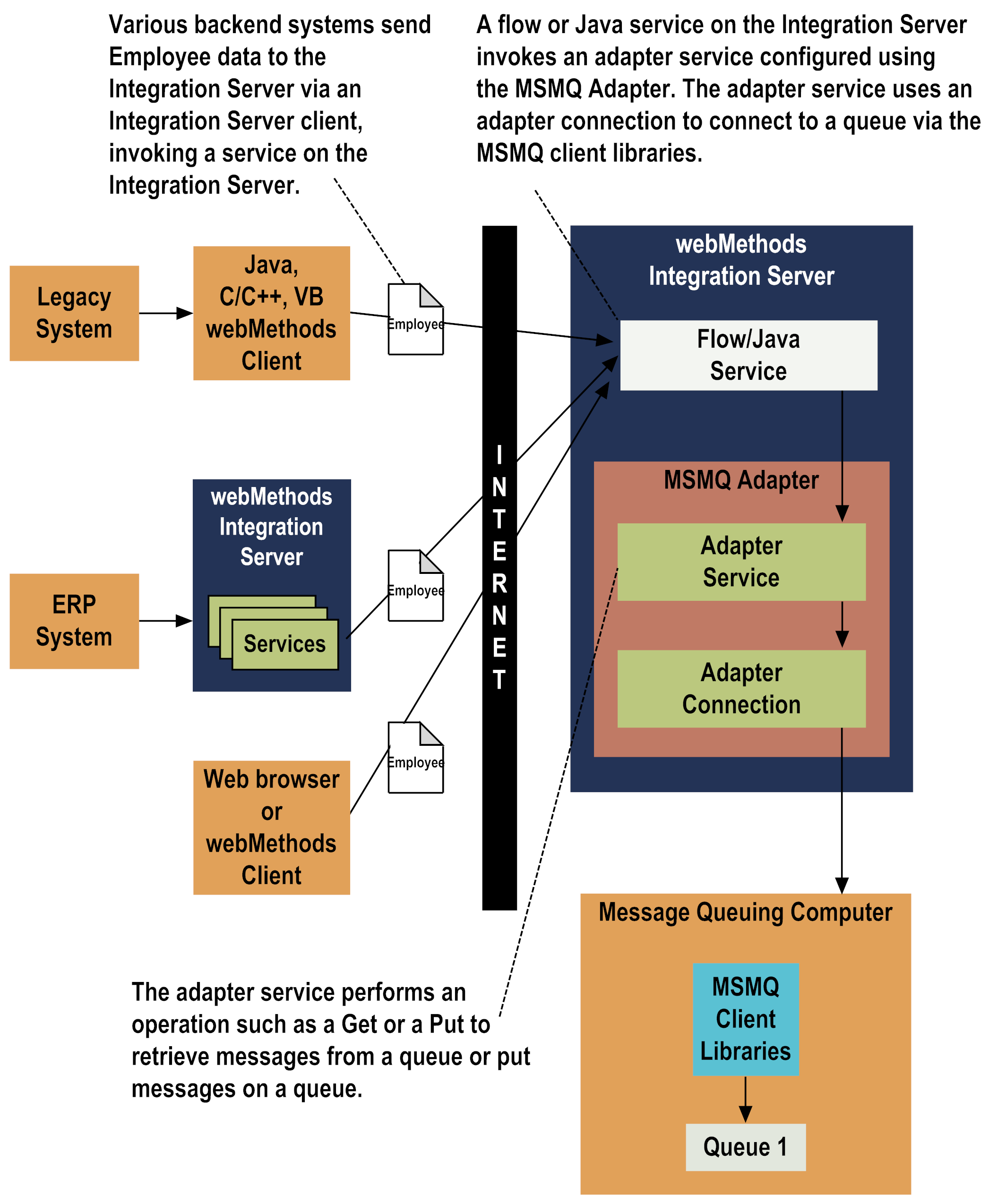Architecture and Components
This diagram illustrates how MSMQ Adapter interfaces with an MSMQ system using the MSMQ libraries. Following the diagram are descriptions of the different architectural pieces involved in the integration process.
For a more detailed description of the run-time data flow for the different types of
MSMQ Adapter services, see
Adapter Services.
 webMethods Integration Server
webMethods Integration Server .
MSMQ Adapter is installed and runs on
Integration Server.
 WmART Package.
WmART Package. The WmART package provides a common framework for
webMethods 6.0 and later adapters to use
Integration Server functionality, making
Integration Server the run-time environment for
MSMQ Adapter. The WmART package is installed with
Integration Server.
 MSMQ Adapter. MSMQ Adapter
MSMQ Adapter. MSMQ Adapter is delivered as a single package called WmMSMQAdapter.
MSMQ Adapter provides
Integration Server Administrator user interfaces that enable you to configure and manage adapter connections and listeners, and
Software AG Designer user interfaces that enable you to configure and manage adapter services and notifications.
 Adapter Connection Templates.
Adapter Connection Templates. Adapter connections enable
MSMQ Adapter to connect to MSMQ systems. You must configure an adapter connection before you can configure adapter services. The adapter provides a template for adapter connections in
Integration Server Administrator. For a detailed description of adapter connections, see
Adapter Connections.
 Adapter Service Templates.
Adapter Service Templates. Adapter services enable
MSMQ Adapter to implement the MSMQ COM libraries to perform operations on MSMQ queues.
MSMQ Adapter provides adapter service templates that enable you to configure services to put, get, and peek messages. For example, a Get service enables you to retrieve messages from a MSMQ queue that are then sent to another application such as a purchase order entry system.
MSMQ Adapter's adapter service templates are available in
Designer. For more information about adapter services and using the adapter service templates, see
Adapter Services.
 Adapter Listener Template.
Adapter Listener Template. An adapter listener monitors the queue for messages and passes the messages to a listener notification. You must configure adapter listeners before you can configure adapter notifications.
MSMQ Adapter provides adapter listener templates that enable you to configure listeners, which monitor a queue for messages. For more information about listeners and how to use them, see
Adapter Listeners and Listener
Notifications.
 Adapter Notification Template.
Adapter Notification Template. A notification waits for an adapter listener to pass a message to a listener notification. A listener notification then passes the messages to
Integration Server. For example, an adapter listener could listen for a specific priority on a queue, such as a priority of 4. The adapter listener monitors the queue for all messages that contain this priority, retrieves the messages from the queue, and then passes them to the adapter listener notification for further processing.
MSMQ Adapter provides adapter notification templates that enable you to configure notifications, which process the message either synchronously or asynchronously. For more information about listener notifications and using the templates, see
Adapter Listeners and Listener
Notifications.
 MSMQ Libraries. MSMQ Adapter
MSMQ Libraries. MSMQ Adapter uses the MSMQ client libraries to communicate with the MSMQ server.
 Message Queuing Computer
Message Queuing Computer. The message queuing computer acts as an intermediary between the programs that want to exchange information. It also functions as a server, controlling the flow of information in and out of a set of queues.
MSMQ Adapter requires that you specify the queue path name when you configure transactional or non-transactional connections. For detailed instructions on how to configure connections, see
Configuring Adapter Connections. For more information about message queueing computer, see
Message Queuing Computer.
 Queue.
Queue. The queue acts as an "inbox" to receive messages from the adapter services and hold messages until other adapter services retrieve them.
MSMQ Adapter requires that you specify the queue name when you configure transactional or non-transactional connections. For detailed instructions on how to configure connections, see
Configuring Adapter Connections. For more information about queues, see
Queuing.
The following diagram illustrates the use of MSMQ Adapter and Integration Server in a business-process integration.


